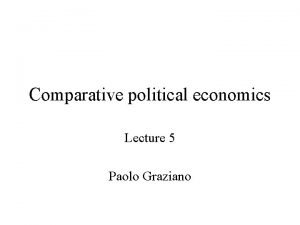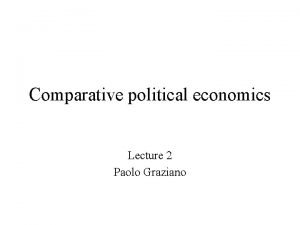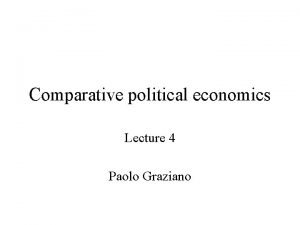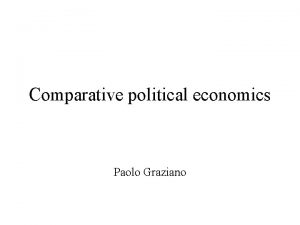Comparative political economics Lecture 3 Paolo Graziano TwoParty








- Slides: 8

Comparative political economics Lecture 3 Paolo Graziano

Two-Party vs. Multiparty Systems • unit of analysis: political party in the legislative and/or governmental arena • ‘clear’ vs. ‘unclear’ choice between alternatives political programs • moderating vs. ‘radicalizing’ effect • prerequisite for single-party vs. coalitional cabinets

How can we count parties? I • Sartori (1976): number of parties in Parliament, over a certain percentage threshold, with coalition (size criterion) or blackmail (ideological criterion) potential • Blondel (1968): attention to power relations within the political system; both number and size are relevant • Laakso and Taagepera (1979): ‘effective’ number of parties index

How can we count parties? II • Power relations among parties: the role of (durable) close alliances in electoral competitions, Parliamentary groups, Cabinets • Power relations within parties: the role of factions • Lijphart solution: closely allied parties and factionalised parties count 1, 5 parties. . .

Partisan conflict dimensions • socioeconomic dimension: role of the State in the economy • religious dimension • cultural-ethnic • urban-rural • regime support • foreign policy (ex. EU) dimension • materialist vs. postmaterialist dimension

Single-party vs. coalition cabinets • single-party majority cabinets • minimal winning cabinets: only those parties that are necessary to reach majority • oversized cabinet: larger coalition cabinets • minority cabinet: not supported by a parliamentary majority

Why oversized cabinets? • ‘information effect’ • policy preferences • nature of the cabinet’s political program: ‘national unity’ or ‘national solidarity’ • institutional/constitutional features • political features: overcome factions

Why minority cabinets? • constitutional/institutional features • party system structure • legislative structure (ex. strenght of Parliamentary committees) • ‘majority governments in disguise’: possible pro tempore situation that will lead to a different majority















